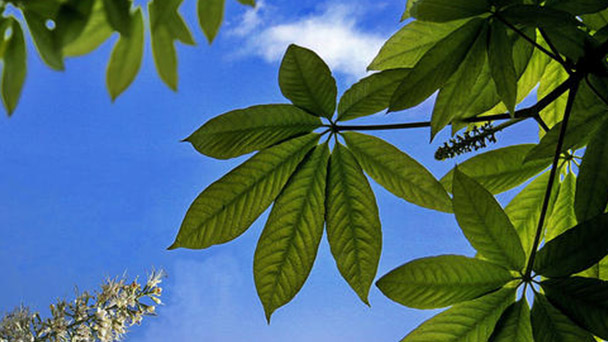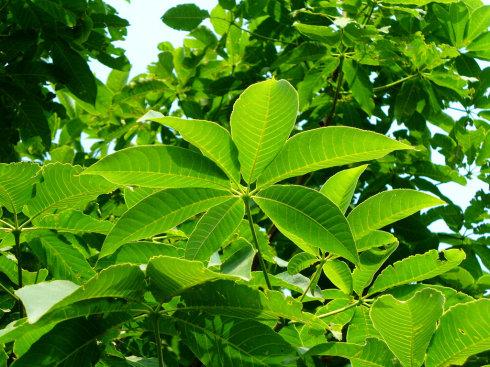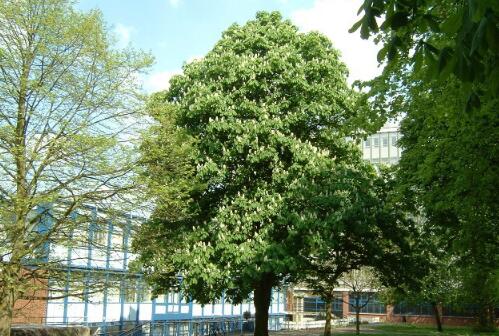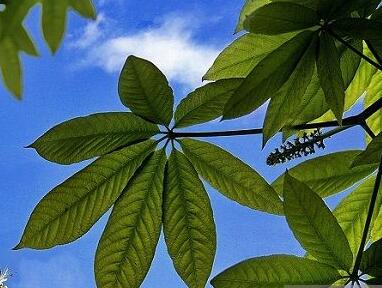Aesculus chinensis (Chinese horse chestnut) profile
Written by Maggie
Mar 15 2021

Aesculus chinensis, commonly called Chinese horse chestnut, is a deciduous tree belonging to the family Aesculus chinensis of the order Aesculus chinensis. The seeds of Aesculus chinensis are edible, but they taste bitter and bitter when eaten directly, and they need to be boiled with alkaline water before they can be eaten. They taste like chestnuts. Starch can also be extracted. All kinds of utensils can be made of fine wood, seeds can be used for medicine, oil can be made of soap.
Aesculus chinensis is one of the most famous ornamental trees in the world for its beautiful trees, large flowers and unusual fruit shapes.
Aesculus chinensis picture

Aesculus chinensis info
| Botanical Name | Aesculus chinensis |
| Common Names | Chinese horse chestnut |
| Plant Type | Tree |
| Sun | Full sun to part shade |
| Hardiness Zones | 5 to 7 |
| Flower color | White |
| Native Area | Northern China |
| Mature size | 30.00 to 40.00 feet high, 30.00 to 40.00 feet wide |
Morphological characteristics of Aesculus chinensis
Aesculus chinensis is a deciduous tree, up to 25 m tall, with dark brown or grayish-brown bark, branchlets, cylindrical, tawny or grayish-brown bark, glabrous or slightly pubescent when tender, and with round or oval pale yellow lenticels. The winter bud is large and resinous. Palmately compound leaves, composed of 5-7 small, petiole 10-12 cm long, gray puberulent; Leaflets of aesculus chinensis are papery, oblong-lanceolate to oblong-oblanceolate, thinly long elliptic K apex short acute, base cuneate or broadly cuneate, margin with obtuse serrate, 8 -- 16 cm long, 3 -- 5 cm wide, dark green above, glabrous, below except for the middle rib and lateral veins at the base of tender pubescent, the rest of the glabrous; Middle rib prominent above, convex below, lateral veins 13 to 17 pairs, slightly prominent above, prominent below; Petiole of central leaflet is 1 -- 1.8 cm long, lateral petiole 5 -- 10 mm long, grayish puberulent.
The inflorescences of Aesculus chinensis are cylindrical, 21 -- 25 cm long with a peduncle 5 -- 10 cm long. The main axis of the inflorescences is puberulent, and the florescences often have 5 -- 10 flowers. Composition, flatly obliquely extended, puberulent, 2 -- 2.5 cm long, pedicels 2 -- 4 mm long.Flowers miscellaneous, male flowers and bisexual flowers of the same plant, calyx tubular campanulate, 3~5 mm long, outside a micropile, unequal to 5 lobes, lobes obtuse, margin with short cilia; Aesculus chinensis has 4 petals, white, oblong-obovate to oblong-oblanceolate, ca. 8 -- 12 mm long, 5 -- 1.5 mm wide, margin ciliated, base clawlike; Aesculus chinensis has 6 stamens, 1.8 -- 3 cm long, filaments linear, glabrous, anthers oblong, pale yellow, ca. 1 -- 1.5 mm long; Ovary is not developed in male flowers, well developed in bisexual flowers, ovoid, style glabrous.
The fruit of Aesculus chinensis is globose or obovate, mucronate or obtuse at the tip and slightly concave at the middle, 3 -- 4 cm in diameter, yellowish-brown, spiny, with very dense spots, the shell is 5 -- 6 millimeters thick when dried, the seeds often 1 -- 2 developed, nearly globose, 2 -- 3.5 cm in diameter, chestnut brown. The hilum is white, accounting for about 1/2 of the volume of the seed.
Ecological habits of Aesculus chinensis
Aesculus chinensis is a light-loving and tolerant to semi-shade, fine lines and humid climates. It is not tolerant to cold and is fond of rich, deep soil.
Propagation of Aesculus chinensis
Aesculus chinensis propagates primarily by sowing
Because Aesculus chinensis seeds are not resistant to the storage, such as drying easily lose vitality, so the seeds should be picked in time after maturity, with the harvest and sowing. In autumn, when the outer appearance of the fruit turned dark brown and cracked can be collected, after the collection of air for 1 to 2 days, peel off the fruit can be used for sowing. Seedling method: loose, fertile, drainage and irrigation convenient lot, after applying enough basic fertilizer to prepare the ground for a bed, and then dig hole sowing.
The seed grains of Aesculus chinensis are large, about 40 grains per kg, and grow rapidly after emergence. The row spacing of plants should be 30×40 (cm) and the depth of holes should be 8~10 cm. When the seed should be planted umbilicus down, covered with soil that must not exceed 3 centimeters, and then covered with grass to protect moisture. Whether sowing in autumn or spring, keep the bed moist during the emergence of seeds. When the seedlings unearthed, remove the grass cover in time. In order to prevent sunburn seedlings, also need to build a shed shade, and often spray water, so that seedlings thrive. The general annual seedling height can reach 80~100 cm, after transplanting cultivation, 3~4 years of seedling height 250~300 cm can be used for landscaping.
The seeds of Aesculus chinensis are high in water content and low in vigor, so they should be stored at low temperature or with sand mixed with peel until the following spring sowing. Pay attention to when sowing seeds umbilicus downward, because the seedling unearthed ability is weak, covered with soil 3~4 cm can be. After sowing 25~30 days germination, seedling period to shade, autumn leaves to the next spring bud before transplantation. After sapling transplantation, do a good job of grass rope wrapped dry work and appropriate shading, to prevent the phenomenon of burning skin withered leaves.

Disease control of Aesculus chinensis
Disease
Burning disease
Summer occurs on tree trunks.
Prevention and control methods: can be in late autumn or early summer in the trunk of the white brush to prevent sunburn, can also be used to cover the base of the trunk with straw or straw, can prevent sunburn.
The whitening agent formula is first 10 parts of quicklime and 2 parts of salt with a small amount of water to open, then add 1 part of sulfur powder, 0.2 powder washing powder mix well, and then add 40 parts of water, mix well.
Thorn moth
Leaf-eating larva, spraying 90% trichlorfon 800~1000 times solution or 15% deltamethrin 4000~5000 times solution in time at the early stage of pest occurrence can achieve good control effect.
Leaf spot, powdery mildew, anthrax
Prevention and control method: can use 70% methyl tobujin wettable powder 1000 times liquid spray.
Insect pests
Scale insect, caterpillar and dung chafer harm, can be used 50% phoxim emulsion 1000 times spray to kill.
The distribution of Aesculus chinensis
Aesculus chinensis is naturally distributed in mountainous areas up to 700m above sea level and is an excellent street and garden tree in the Yellow River Basin.
Aesculus chinensis is found in southern Hebei, southern Shanxi, northern Henan, and southern Shaanxi provinces, but only in the Qinling Mountains.
The type specimen of Aesculus chinensis was collected from the Xishan Mountains of Beijing.
Aesculus Chinensis, a natural active ingredient, promotes microcirculation and maintains normal cell metabolism by inhibiting enzymes such as collagenase, which are closely related to skin texture and integrity, thereby promoting pore aggregation, cleansing, nourishing, and delicate skin.
Aesculus chinensis uses
Landscape use of Aesculus Chinensis
In China, Aesculus Chinensis has a deep connection with Buddhism, which has been found in many famous ancient monasteries such as Lingyin Temple in Hangzhou, Reclining Buddha Temple in Beijing, and Dajue Temple for over a thousand years.
Aesculus chinensis has a straight trunk, a large crown and a thick shade. It is full of flowers in early summer, and its large white inflorescence looks like an ornate candles candle. Aesculus chinensis is an excellent ornamental tree for pedestrians, parks and public squares, and can be planted alone or in groups, or mixed with evergreen and broadleaf trees. The scenery is very beautiful when the flowers are in bloom.
In China, Aesculus chinensis is often planted alone or in front of buildings or between open forests. There are a large number of Aesculus chinensis species in China and they are widely distributed, but most of them are still in the stage of not being properly managed and utilized.
Aesculus chinensis other uses
Aesculus chinensis can be used as food, medicine, wood, etc. The buds can be used as a tea, the skin and root can be used as soap, the leaves and flowers can be used as a dye, the seeds can be used as starch extraction, oil extraction, edible, taste similar to chestnut, and can be used as a medicine, tranquilizing the mind, qi, insecticide and so on. Wood is light and can be used for papermaking, carving, furniture and handicrafts.

Latest Updated
- Benefits of Bugleweed - 7 Science-backed Health Benefits
- Bugleweed Dangers & Side Effects - Is It Poisonous?
- How to Plant Evergreen Trees - What You Should Know
- When to Plant Evergreens - Grow Guide for Evergreen Trees
- 12 Wonderful Evergreen Shrubs for Your Garden
- 12 Popular Evergreen Plants with Pictures for Beginners
- When And How To Prune A Lilac Bush Like a Pro
- How to Grow & Care for Lilac Vine (Hardenbergia Violacea)
- Japanese Lilac Tree (Syringa Reticulata) Care & Propagation Guide
- Shumard Oak Pros and Cons - What to Know
Popular Articles
- Winter maintenance of Antirrhinum Majus
- How to Grow Terminalia Mantaly Tree
- How to Grow and Care for Crossostephium Chinense
- How to grow Antirrhinum Majus in spring
- Peristeria Elata (Dove Orchid) Profile: Info & Care Guide
- Underwatered Snake Plant (Sansevieria Trifasciata) - Signs And How To Fix
- How to Care for Brazilian Jasmine Plant (Mandevilla Sanderi)
- How to Grow & Care for Graptopetalum Purple Delight in Summer
- Rosa Chinensis (China Rose): Plant Growing & Care Tips
- How to Care for Baby Sun Rose (Aptenia Cordifolia)